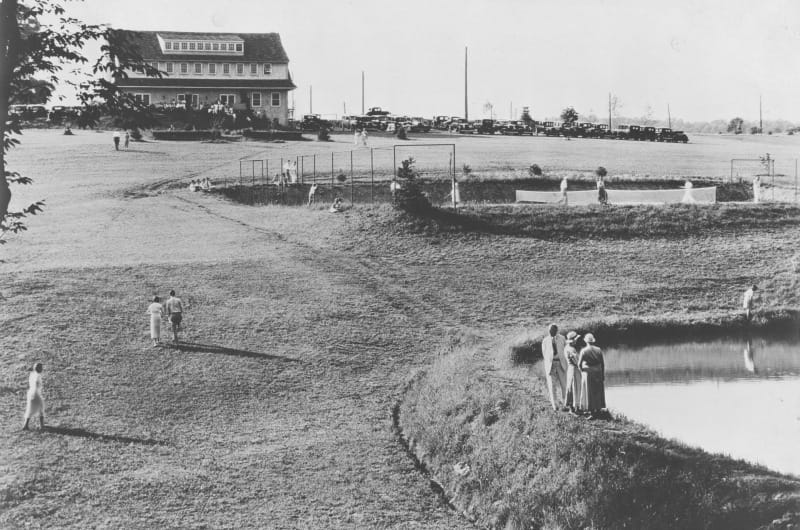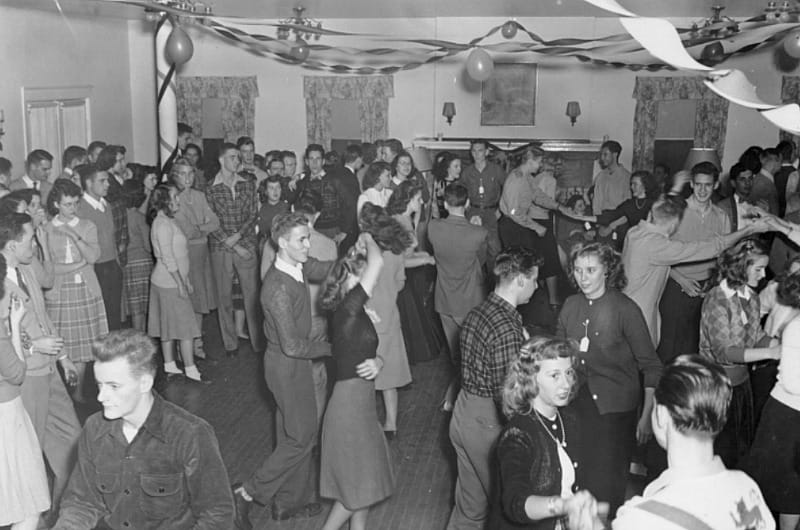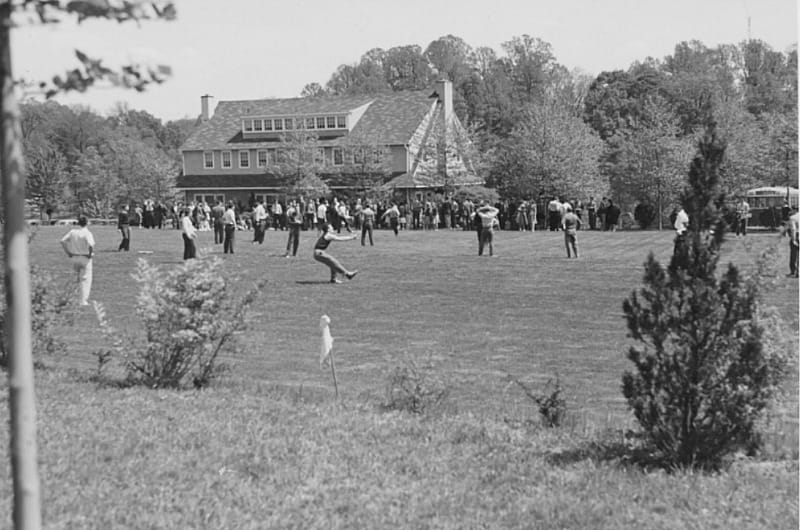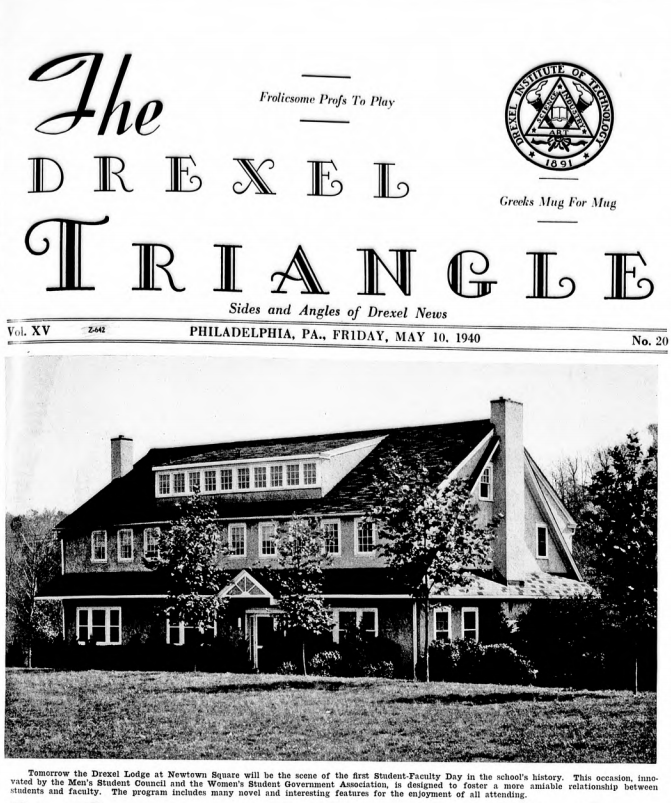The Drexel Country Getaway You’ve Probably Never Heard Of

This article is part of the DrexelNow “Faces of Drexel” series honoring Drexel’s history as part of the University-wide celebration of the 125th anniversary of Drexel’s founding in 1891.
Throughout its 125 years, Drexel has always been an urban school. But for about half of the University’s life, students, faculty and staff had the opportunity to escape the hustle and bustle of the concrete jungle surrounding campus in a way that seems unthinkable to today’s Dragons.
From 1931 to 1991, members of the Drexel community had the opportunity to connect off campus at the Drexel Lodge, a country estate located a half-hour’s drive away in Newtown Township. Located on about 20 acres of land in a pine forest, the Depression-era lodge was a popular destination for dances, picnics, club meetings, sporting events and even overnight stays.
It all began in 1929, when A.J. Drexel Paul, the grandson of founder Anthony J. Drexel and a longtime member of the Drexel Institute of Art, Science and Industry’s board of trustees, donated land located on West Chester Pike. A three-story lodge was built and opened in 1931 and immediately became a popular destination for the institute’s special events.

Built in the Dutch Colonial style, the building’s first floor contained a reception room, dance floor, stage and dressing rooms, kitchen and convenience store where students could purchase groceries. The second story held two dormitories capable of sleeping 50 people, a dressing room and a room for chaperones. A gymnasium was even built on the third floor.
Outside, the opportunities for fun were even larger, especially in the warmer months. There were two ponds on the estate, plus a garage, a picnic area and five playing fields, including a regulation-size football field that the Drexel football team used for preseason activities for decades. There was enough land and equipment at the Lodge to play pretty much any outdoor sport available: badminton, croquet, volleyball, horseback riding, lacrosse, basketball, soccer and football, among others. Marshmallows, steaks and hot dogs were roasted over open fires and singalongs and skits played out under the glowing stars. The picturesque grounds were also perfect for hikes.
The Drexel Lodge hosted everything from hoedowns and Halloween parties to Valentine’s Day dances and Easter egg hunts. Fraternities and sororities regularly held meetings and events at the Drexel Lodge, as did academic departments, student groups, alumni organizations, athletic teams and faculty clubs. Prospective students from nearby high schools were even bused to the Lodge to learn more about Drexel.

Between the 1940s and the end of the 1960s, it was the home of the annual Student-Faculty Day, a Drexel holiday in which students and faculty got to know each other outside of classes as they competed in tug-of-war matches and played softball, badminton and volleyball games. About 350 people attended in 1949 — 80 pounds of potatoes were used that year to create enough potato salad for all to enjoy.
Originally open only in the spring and summer months, the Drexel Lodge eventually opened year-round. Caretakers, usually a married couple, maintained the estate as housekeepers and lived in a separate apartment space on the second floor of the building.
The Drexel Lodge was maintained through the donations of Drexel organizations over the years. When the estate was first opened, it was furnished by various groups: Drexel’s Rifle Club donated a davenport sofa and two jade green Smokador ashtrays; the comptroller provided for the purchase of a refrigerator; and Alexander Van Rensselaer, son-in-law of Drexel’s founder and president of the board of trustees, gave a piano. The Drexel Students Home Economics Club outfitted the dining room with cups and saucers, fruit dishes and plates (both dinner and bread and butter plates). Drexel’s Athletic Association provided for purchase of cooking utensils including measuring cups, mixing bowls, an eggbeater, a can-opener, a 10-quart kettle and a frying pan.

But as the years and decades went on, it became harder and harder to care for the Drexel Lodge. In 1975, a fire broke out due to a faulty seal on the fuel pump in the oil burner, causing thousands of dollars in damages in the basement, including a recreational center and storage space. By then, the University was charging $50 a day to hold events there (when the Drexel Lodge opened, it could be used at no cost) and it was rented at a higher cost for non-University events like weddings and receptions. Unfortunately, that still wasn’t enough for the upkeep.
The Drexel Lodge held out for another 16 years before it was officially closed in 1991. The University was in rough financial shape and budget cuts called for the closure of the Depression-era building, which was out of code and in need of costly repairs. In 1995, the University sold the building and the land to Newtown Township for $900,000.
Today, the Drexel Lodge lives on as part of Drexel Lodge Park, the largest public space on West Chester Pike. Some of its playing fields and ponds still exist on the grounds. Fittingly, it is also home to the Newtown Square Pennsylvania Railroad Museum — something that Anthony J. Drexel, whose banking company financed the creation of many railroads, especially those in his home state, might have appreciated.
In This Article
Drexel News is produced by
University Marketing and Communications.

